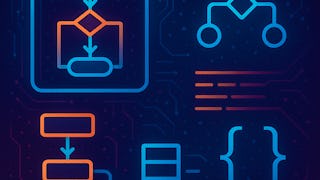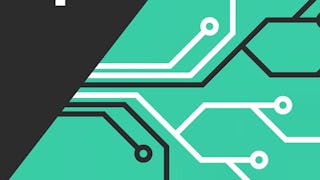A good algorithm usually comes together with a set of good data structures that allow the algorithm to manipulate the data efficiently. In this online course, we consider the common data structures that are used in various computational problems. You will learn how these data structures are implemented in different programming languages and will practice implementing them in our programming assignments. This will help you to understand what is going on inside a particular built-in implementation of a data structure and what to expect from it. You will also learn typical use cases for these data structures.

Enjoy unlimited growth with a year of Coursera Plus for $199 (regularly $399). Save now.

Data Structures
This course is part of Data Structures and Algorithms Specialization



Instructors: Neil Rhodes
301,098 already enrolled
Included with
(5,560 reviews)
Recommended experience
Skills you'll gain
Details to know

Add to your LinkedIn profile
9 assignments
See how employees at top companies are mastering in-demand skills

Build your subject-matter expertise
- Learn new concepts from industry experts
- Gain a foundational understanding of a subject or tool
- Develop job-relevant skills with hands-on projects
- Earn a shareable career certificate

There are 6 modules in this course
In this module, you will learn about the basic data structures used throughout the rest of this course. We start this module by looking in detail at the fundamental building blocks: arrays and linked lists. From there, we build up two important data structures: stacks and queues. Next, we look at trees: examples of how they’re used in Computer Science, how they’re implemented, and the various ways they can be traversed. Once you’ve completed this module, you will be able to implement any of these data structures, as well as have a solid understanding of the costs of the operations, as well as the tradeoffs involved in using each data structure.
What's included
7 videos7 readings1 assignment1 programming assignment
In this module, we discuss Dynamic Arrays: a way of using arrays when it is unknown ahead-of-time how many elements will be needed. Here, we also discuss amortized analysis: a method of determining the amortized cost of an operation over a sequence of operations. Amortized analysis is very often used to analyse performance of algorithms when the straightforward analysis produces unsatisfactory results, but amortized analysis helps to show that the algorithm is actually efficient. It is used both for Dynamic Arrays analysis and will also be used in the end of this course to analyze Splay trees.
What's included
5 videos1 reading1 assignment
We start this module by considering priority queues which are used to efficiently schedule jobs, either in the context of a computer operating system or in real life, to sort huge files, which is the most important building block for any Big Data processing algorithm, and to efficiently compute shortest paths in graphs, which is a topic we will cover in our next course. For this reason, priority queues have built-in implementations in many programming languages, including C++, Java, and Python. We will see that these implementations are based on a beautiful idea of storing a complete binary tree in an array that allows to implement all priority queue methods in just few lines of code. We will then switch to disjoint sets data structure that is used, for example, in dynamic graph connectivity and image processing. We will see again how simple and natural ideas lead to an implementation that is both easy to code and very efficient. By completing this module, you will be able to implement both these data structures efficiently from scratch.
What's included
15 videos6 readings3 assignments1 programming assignment1 plugin
In this module you will learn about very powerful and widely used technique called hashing. Its applications include implementation of programming languages, file systems, pattern search, distributed key-value storage and many more. You will learn how to implement data structures to store and modify sets of objects and mappings from one type of objects to another one. You will see that naive implementations either consume huge amount of memory or are slow, and then you will learn to implement hash tables that use linear memory and work in O(1) on average! In the end, you will learn how hash functions are used in modern disrtibuted systems and how they are used to optimize storage of services like Dropbox, Google Drive and Yandex Disk!
What's included
20 videos4 readings2 assignments1 programming assignment
In this module we study binary search trees, which are a data structure for doing searches on dynamically changing ordered sets. You will learn about many of the difficulties in accomplishing this task and the ways in which we can overcome them. In order to do this you will need to learn the basic structure of binary search trees, how to insert and delete without destroying this structure, and how to ensure that the tree remains balanced.
What's included
7 videos2 readings1 assignment
In this module we continue studying binary search trees. We study a few non-trivial applications. We then study the new kind of balanced search trees - Splay Trees. They adapt to the queries dynamically and are optimal in many ways.
What's included
4 videos2 readings1 assignment1 programming assignment
Earn a career certificate
Add this credential to your LinkedIn profile, resume, or CV. Share it on social media and in your performance review.
Instructors



Offered by
Explore more from Algorithms
 Status: Preview
Status: PreviewBirla Institute of Technology & Science, Pilani
 Status: Free Trial
Status: Free TrialUniversity of Illinois Urbana-Champaign
 Status: Free Trial
Status: Free Trial Status: Free Trial
Status: Free TrialUniversity of Illinois Urbana-Champaign
Why people choose Coursera for their career




Learner reviews
5,560 reviews
- 5 stars
73.56%
- 4 stars
20.62%
- 3 stars
3.59%
- 2 stars
0.77%
- 1 star
1.43%
Showing 3 of 5560
Reviewed on Feb 7, 2020
Excellent review on data structures. I've taken a graduate level course covering advanced data structures, but I was still able to learn new things through the challenging assignments.
Reviewed on Nov 22, 2019
The lectures and the reading material were great. The assignments are challenging and require thought before attempting. The forums were really useful when I got stuck with the assignments
Reviewed on Dec 14, 2020
This is one of the appreciable
Frequently asked questions
To access the course materials, assignments and to earn a Certificate, you will need to purchase the Certificate experience when you enroll in a course. You can try a Free Trial instead, or apply for Financial Aid. The course may offer 'Full Course, No Certificate' instead. This option lets you see all course materials, submit required assessments, and get a final grade. This also means that you will not be able to purchase a Certificate experience.
When you enroll in the course, you get access to all of the courses in the Specialization, and you earn a certificate when you complete the work. Your electronic Certificate will be added to your Accomplishments page - from there, you can print your Certificate or add it to your LinkedIn profile.
Yes. In select learning programs, you can apply for financial aid or a scholarship if you can’t afford the enrollment fee. If fin aid or scholarship is available for your learning program selection, you’ll find a link to apply on the description page.
More questions
Financial aid available,







